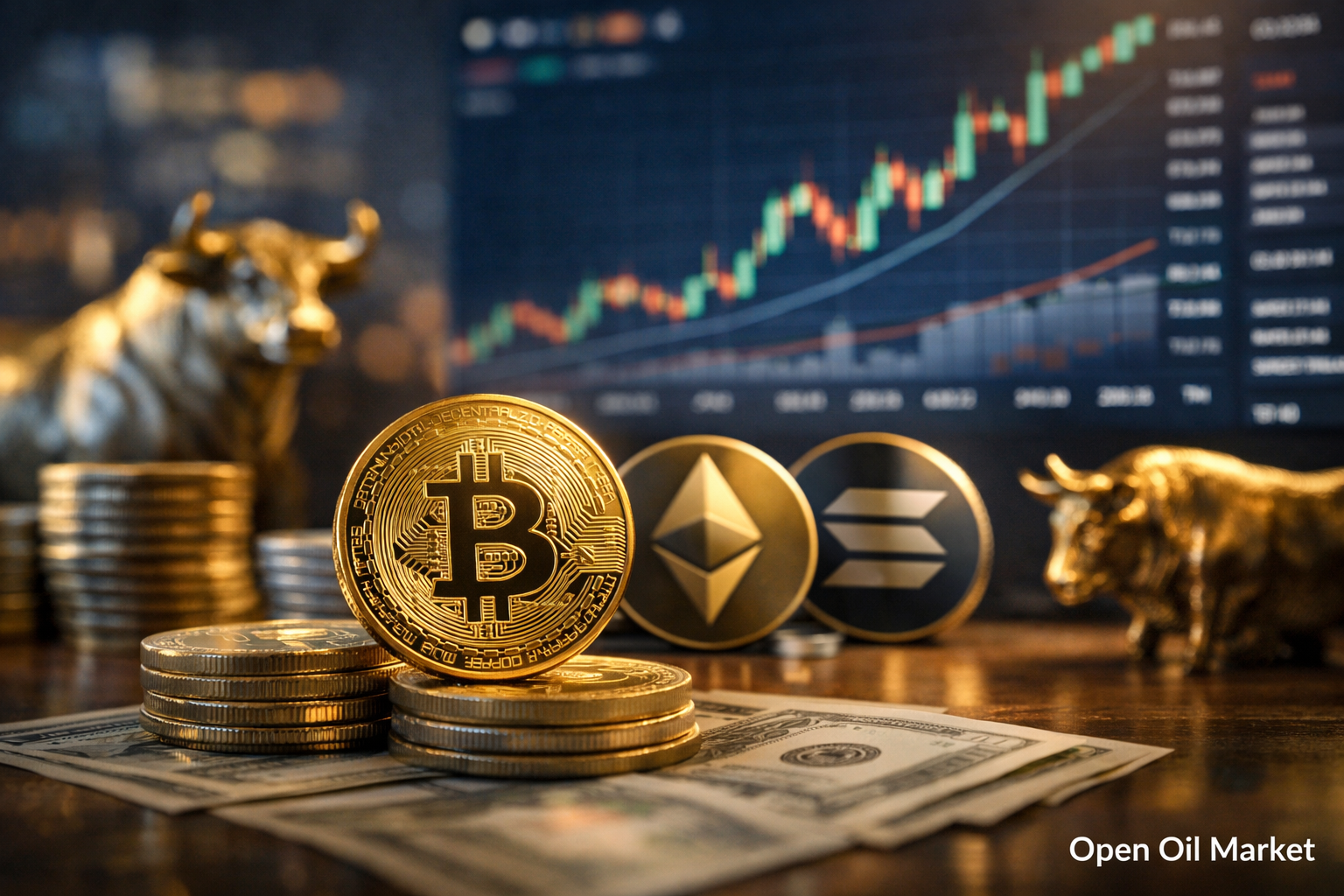
Recent Cryptocurrency News on October 19, 2025: Bitcoin Dynamics, Altcoin Trends, Changes in DeFi and NFT Markets, Regulation, Top 10 Coins, and Macro-Economic Context
Market Overview: A Volatile Week
Following a rapid increase at the beginning of the month and the updating of historical highs, digital asset prices faced a sharp correction. Investors were reallocating risks amid a combination of market and macroeconomic factors.
Bitcoin: Correction After the Historical High
The flagship cryptocurrency Bitcoin (BTC) surpassed previous records in early October, soaring to ~$126,000. However, last week, the market reversed: prices dropped approximately 15% from the peak. Bitcoin briefly fell below the $106,000 mark amid a wave of margin position liquidations and an overall retreat of investors from riskier assets.
By the end of the week, BTC consolidated around $107–110,000, roughly 7–10% lower than the levels seven days prior. The fundamental indicators of the Bitcoin network remain strong: the total hashrate is holding around record levels (over 1000 EH/s), reflecting miners' confidence. Some long-term holders capitalized on the price decline to accumulate positions — on-chain data indicates signs of accumulation, even as short-term speculators exited the market.
Ethereum: Network Activity Despite Price Decline
The second-largest cryptocurrency, Ethereum (ETH), mirrored Bitcoin's dynamics. After rising to ~$4,500 at the beginning of October, Ethereum's price retreated and closed the week around $3,900. The week brought about an 8–10% decrease for ETH, yet the fundamental indicators signal ongoing development within the Ethereum ecosystem.
The Ethereum network continues to showcase high levels of activity: the number of active unique addresses exceeds 600,000 daily. Additionally, over 35 million ETH (approximately 30% of the total supply) is currently engaged in staking, demonstrating investor confidence in the Proof-of-Stake mechanism. Ethereum remains the foundation for decentralized finance (DeFi) and NFT platforms.
Altcoins: Mass Decline and Volatility
Amid the correction of market leaders, other cryptocurrencies also felt the impact. Many major altcoins faced pressure from sell-offs as investors sought to reduce risks by exiting more volatile assets. As a result, the total market capitalization of cryptocurrencies shrank to approximately $3.7 trillion, losing about 12% from the peak values at the beginning of the month.
The capitulation within the altcoin segment was widespread. For instance, Solana (SOL) and XRP prices dropped approximately 15% over the week, while tokens like Dogecoin (DOGE) and Cardano (ADA) fell nearly 20%. Even the relatively resilient token BNB decreased by more than 10%. Such a synchronized drop suggests that investors conducted a broad reevaluation of their portfolios, preferring to ride out the turbulence in more stable assets or stablecoins.
Top 10 Most Popular Cryptocurrencies
As of mid-October 2025, the ten largest and most popular cryptocurrencies by market capitalization are as follows:
- Bitcoin (BTC) – the largest cryptocurrency (market cap > $2 trillion), currently around $107,000 per coin. Bitcoin sets the tone for the entire market and is often seen as "digital gold."
- Ethereum (ETH) – the second-largest digital asset (~$3,900; market cap ~$460 billion). Ethereum underpins the DeFi and NFT ecosystems; the network's transition to Proof-of-Stake and the accumulation of ~35 million ETH in staking bolster investor confidence in the project's long-term development.
- Tether (USDT) – the largest stablecoin pegged to the US dollar (market cap around $80 billion). USDT consistently holds at $1.00 and is widely used in trading and settlements, providing high liquidity in the cryptocurrency market.
- BNB (BNB) – the native token of Binance exchange and its blockchain (~$1,080; market cap ~$170 billion). BNB offers discounts on fees and serves as a key element of the Binance ecosystem; its price significantly increased over the past year despite regulatory risks surrounding cryptocurrency exchanges.
- USD Coin (USDC) – the second most significant dollar-pegged stablecoin (market cap ~$30 billion), fully backed by reserves. USDC trades steadily around $1.00 and enjoys a reputation as a transparent and regulated asset used in payments and DeFi.
- XRP (XRP) – a token aimed at global banking payments (~$2.3; market cap > $100 billion). Following the landmark 2023 court case (Ripple case), interest in XRP from major players has increased; XRP remains one of the market leaders, particularly in cross-border transfers.
- Solana (SOL) – the coin of the high-speed Solana blockchain (~$185; market cap ~$70 billion). Thanks to the growth of DeFi and NFT applications based on Solana, this asset is regaining investor attention; the network has become more resilient, although SOL's price volatility remains high.
- Cardano (ADA) – the cryptocurrency of the Cardano platform (Proof-of-Stake) (~$0.63; market cap ~$22 billion). The project stands out with a research-driven approach, although ADA's price growth remains muted; the implemented technological updates strengthen the underlying network for the future.
- Dogecoin (DOGE) – a "meme" cryptocurrency (~$0.18; market cap ~$27 billion). DOGE is highly volatile and depends on retail investor sentiment, yet due to a supportive community, it continues to hold a place in the top 10.
- Tron (TRX) – the token of the Tron blockchain platform (~$0.31; market cap ~$28 billion). Tron is known for its high throughput and is actively used for issuing stablecoins (a significant portion of USDT circulates on this network); its popularity in Asia helps TRX secure a spot among the top cryptocurrencies.
Institutional Investors and Market Sentiments
After months of capital inflow, institutional investors paused this week, partially taking profits. There was a sharp outflow of funds from exchange-traded crypto funds (amounting to several hundred million dollars), while a wave of forced liquidations in the derivatives market underscored the market's nervousness. The overwhelming majority of liquidated positions were long, reflecting a shift in sentiment from excessive optimism to a sharp cooling off.
The rapid price decline adversely affected market sentiment: the Crypto Fear & Greed Index fell into the "extreme fear" territory (~22 points) – just a week ago, it was in the greed zone. However, there are encouraging signals: analysts note that some long-term investors (including institutional funds) are using this pullback to accumulate Bitcoin and Ethereum at lower prices. Blockchain data indicates a rise in the balances of large addresses, signaling a long-term accumulation of coins. This suggests that despite the short-term fright, strategic investors continue to believe in the upward trend of the industry and view the current correction as an entry opportunity.
Regulation and Macroeconomics
External factors and regulatory news have significantly influenced the cryptocurrency market in recent days. Macroeconomic uncertainty has intensified following prominent geopolitical statements. In particular, US President Donald Trump announced plans to impose 100% tariffs on all imports from China, escalating trade tensions between the two largest economies. These threats, made at the end of last week, triggered a sell-off of risk assets: Bitcoin plummeted over 12% in a matter of hours, with total liquidations in the derivatives market reaching billions of dollars. However, by Sunday, the rhetoric softened: the US administration expressed a willingness to engage in dialogue, and Trump assured via social media that he "doesn't want to harm China." In light of these comments, global markets, including cryptocurrencies, received a respite — Bitcoin and Ethereum quotes rebounded from local lows, though they did not completely recover previous losses.
Meanwhile, regulators from various countries continued to shape oversight frameworks for digital assets. At the global level, the Financial Stability Board (FSB) published a report highlighting persistent gaps in cryptocurrency regulation and calling for coordinated actions. The FSB pointed out the need for implementing uniform global standards, enhancing oversight over stablecoins and crypto platforms, and developing mechanisms to prevent the transfer of risks from the crypto sphere to traditional finance. In the European Union, a comprehensive MiCA regulation will come into force in 2024, while the US is discussing new rules (launching spot ETFs and legislating the status of digital assets) — these steps aim to increase market transparency. These processes indicate a gradual institutionalization of the sector: while regulatory news may trigger market fluctuations in the short term, clearer rules could attract even more investors in the long run.
Market Outlook
The future trajectory of the cryptocurrency market will depend on macroeconomic conditions and progress in regulation. If monetary policy eases (for example, through interest rate cuts amid slowing inflation), the appetite for riskier assets may increase, supporting demand for cryptocurrencies. Simultaneously, technological advancements and the launch of new investment products (including crypto-ETFs) could attract additional capital. While volatility remains high, the industry is maturing — infrastructure is improving, and integration with traditional finance is growing. Many analysts expect that after the current correction, the market will resume its growth, relying on internal innovations and favorable external factors.




